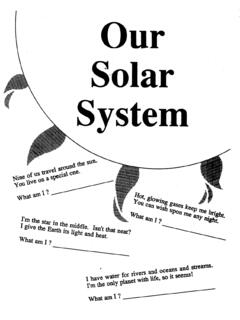Transcription of Chapter 10 Principles of Photogrammetry The geometry of …
1 EM 1110-1-100031 Mar 93 Chapter 10 Principles of Photogrammetry10-1. GeneralThe purpose of this Chapter is to review the principlesof Chapter contains backgroundinformation and references that support the standardsand guidelines found in the previous chapters. Section Ireviews the basic elements of Photogrammetry with anemphasis on obtaining quantitative information fromaerial photographs. Section II discusses basic operation-al Principles of stereoplotters. Section III summarizesthe datums and reference coordinate systems commonlyencountered in photogrammetric IVdiscusses the Principles of aerotriangulation. Section Vprovides background information for mosaics more generalized nontechnicaloverview of Photogrammetry may be found in Appen-dix IElements of Photogrammetry10-2. GeneralThe purpose of this section is to review the basic geom-etry of aerial photography and the elements of photo-grammetry that form the foundation of DefinitionPhotogrammetry can be defined as the science and art ofdetermining qualitative and quantitative characteristicsof objects from the images recorded on are identified and qualitativelydescribed by observing photographic image characteris-tics such as shape, pattern, tone, and texture.
2 Identifica-tion of deciduous versus coniferous trees, delineation ofgeologic landforms, and inventories of existing land useare examples of qualitative observations obtained fromphotography. The quantitative characteristics of objectssuch as size, orientation, and position are determinedfrom measured image positions in the image plane ofthe camera taking the photography. Tree heights, stock-pile volumes, topographic maps, and horizontal andvertical coordinates of unknown points are examples ofquantitative measurements obtained from geometry of Aerial PhotographyThe geometry of a single vertical photograph is shownin Figure 10-1. The photographic negative is shown forcompleteness, but in practice it is typical to work withthe photographic positive printed on paper, film, orglass. The front nodal point of the camera lens is de-fined as the exposure station of the points are those points in the camera lens systemsuch that any light ray entering the lens and passingthrough the front nodal point will emerge from the rearnodal point travelling parallel to the incident light , the positive photograph can be shown on theobject side of the camera lens, positioned such that theobject point, the image point, and the exposure stationall lie on the same straight line.
3 The line through thelens nodal points and perpendicular to the image planeintersects the image plane at the principal point. Thedistance measured from the rear nodal point to the nega-tive principal point or from the front nodal point to thepositive principal point is equal to the focal lengthfofthe camera Single vertical Aerial PhotographyFigure 10-1. Single vertical photograph geometryVertical photographs, exposed with the optical axisvertical or as nearly vertical as possible, are the princi-pal kind of photographs used for mapping. If the axis is10-1EM 1110-1-100031 Mar 93perfectly vertical , the resulting photograph is termed a"truly vertical " photograph. In spite of the precautionstaken to maintain the vertical camera axis, small tilts areinvariably present; but these tilts are usually less than1 degree and they rarely exceed 3 degrees.
4 Photographscontaining these small, unintentional tilts are called"near vertical " or "tilted" of theequations developed in this Chapter are for truly verticalphotographs, but for certain work, they may be appliedto near vertical photos without serious to account for tilted photographs, and noaccuracy whatsoever need be lost in using Photographic scale of an aerial pho-tograph can be defined as the ratio between an imagedistance on the photograph and the corresponding hori-zontal ground that if a correct photo-graphic scale ratio is to be computed using this defini-tion, the image distance and the ground distance must bemeasured in parallel horizontal planes. This conditionrarely occurs in practice since the photograph is likelyto be tilted and the ground surface is seldom a flat hori-zontal plane.
5 Therefore, scale will vary throughout theformat of a photograph, and photographic scale can bedefined only at a point.(1) The scale at a point on a truly vertical photo-graph is given by(10-1)SfHhwhereS= photographic scale at a pointf= camera focal lengthH= flying height above datumh= elevation above datum of the pointEquation 10-1 is exact for truly vertical photographs andis typically used to calculate scale on nearly verticalphotographs.(2) In some instances, such as flight planning calcu-lations, approximate scaled distances are ground points are assumed to lie at an average eleva-tion, an average photographic scale can be adopted fordirect measurements of ground distances. Average scaleis calculated by(10-2)SavefHhavewherehaveis the average ground elevation in the referring to the vertical photograph shown in Fig-ure 10-2, the approximate horizontal length of the lineAB is(10-3)D dHhavefwhereD= horizontal ground distanced= photograph image distanceFigure 10-2.
6 horizontal ground coordinates fromsingle vertical photograph10-2EM 1110-1-100031 Mar 93 The flat terrain assumption, however, introduces scalevariation errors. For accurate determinations of horizon-tal distances and angles, the scale variation caused byelevation differences between points must be accountedfor in the photogrammetric ground distances and angles can be computed usingcoordinate geometry if the horizontal coordinates of theground points are 10-2 illustrates thephotogrammetricsolutiontodeterminehor izontalground coordinates.(1) horizontal ground coordinates can be calculatedby dividing each photocoordinate by the true photo-graphic scale at the image point. In equation form, thehorizontal ground coordinates of any point are given by(10-4)Xpxp(Hhp)fYpyp(Hhp)fwhereXp,Yp= ground coordinates of pointpxp,yp= photocoordinates of pointphp= ground elevation of pointpNote that these equations use a coordinate system de-fined by the photocoordinate axes having an origin atthe photo principal point and the x-axis typicallythrough the midside fiducial in the direction of the local ground coordinate axes are placed paral-lel to the photocoordinate axes with an origin at theground principal point.
7 (2) The equations for horizontal ground coordinatesare exact for truly vertical photographs and typicallyused for near vertical photographs.(3) After the horizontal ground coordinates of pointsA and B in Figure 10-2 are computed, the horizontaldistance is given by(10-5)DAB(XaXb)2(YaYb)2 This solution is not an approximation because the effectof scale variation caused by unequal elevations is in-cluded in the computation of the ground coordinates. Itis important to note, however, that the elevationshaandhbmust be known before the horizontal ground coordi-nates can be computed. The need to know elevation canbe overcome if a stereo solution is displacement is an-other characteristic of the perspective geometry recordedby an aerial photograph. The displacement of an imagepoint caused by changes in ground elevation is closelyrelated to photographic scale variation.
8 Relief displace-ment is evaluated when analyzing or planning mosaic ororthophoto projects. Relief displacement is also a toolthat can be used in photo interpretation to determineheights of vertical objects.(1) The displacement of photographic images causedby differences in elevation is illustrated in Figure image displacement is always along radial linesfrom the principal point of a truly vertical photograph orthe nadir of a tilted magnitude ofrelief displacement is given by the formula(10-6)drhHwhered= image displacementr= radial distance from the principal point to theimage pointH= flying height above ground(2) Since the image displacement of a vertical objectcan be measured on the photograph, Equation 10-6 canbe solved for the height of the object to obtain(10-7)htd(Hhbase)rtopwhereht= vertical height of the objecthbase= elevation at the object base above datum10-3EM 1110-1-100031 Mar 93 Remember, heights of vertical objects can be determinedFigure 10-3.
9 Relief displacement on a verticalphotographon a single photograph, but elevation above datumcannot be Exterior Orientation of Tilted PhotographsUnavoidable aircraft tilts cause aerial photographs to beexposed with the camera axis tilted slightly from verti-cal, and the resulting pictures are called tilted photo-graphs. The equations given above are exact for trulyvertical photographs, and they are used with near verti-cal photography for planning, estimating, and , an accurate photogrammetricsolution using aerial photographs must account for thecamera position and tilt at the instant of exterior orientation of a photograph is itsspatial position and angular orientation with respect tothe ground coordinate independentparameters are required to define exterior space position is normally given by three-dimensional coordinates of the exposure station in aground coordinate vertical coordinatecorresponds to the flying height above datum.
10 Angularorientation is the amount and direction of tilt in angles are sufficient to define angularorientation, and two different systems are commonlyused:the tilt-swing-azimuth system (t-s- ) and theomega-phi-kappa system ( , , ).The omega-phi-kappasystempossessescertaincom putationaladvantages over the tilt-swing-azimuth system, but thetilt-swing-azimuth system is perhaps more easily 10-4 illustrates the parameters used toexpress exterior orientation of an aerial tilt-swing-azimuth system is appropriate forFigure 10-4. Exterior orientation of an aerialphotographhand calculations. An auxiliary photocoordinate systemis defined with an origin at the photo nadir andy axisalong the direction of tilt. The expression for scale on atilted photograph is(10-8)Sfcost(y sint)Hh10-4EM 1110-1-100031 Mar 93wherey = auxiliary photocoordinatet= photo tilt tilt of aerial mapping photography is seldomlarge enough to require using tilted photograph equa-tions for hand calculations when planning and estimat-ing projects.




